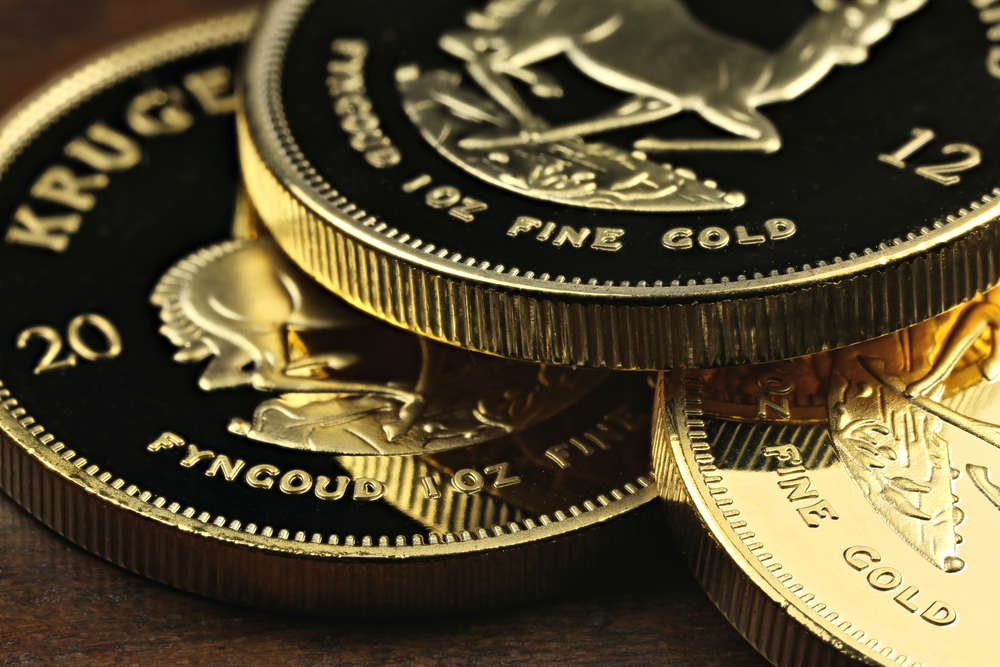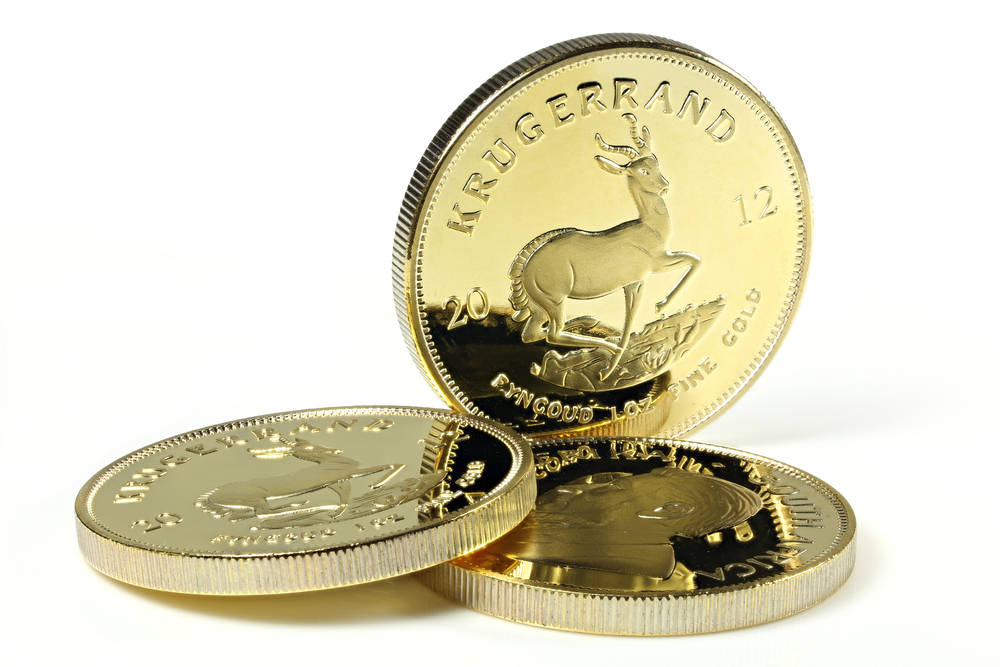
How Much is a Krugerrand Gold Coin Worth?
Gold coins are minted across the globe. Some are made out of pure gold, and some are not. Then there are also gold bullion coins that may or may not be eligible for a gold IRA.
While gold coins qualifying for a precious metals IRA arrangement have some level of exclusiveness, those that aren’t eligible aren’t duds in comparison. They are also worth more than their melt values. And greater the historicity, rarity, and other attributes attached to them, the higher is their market value. One such coin is the South African gold Krugerrand coin.

The Krugerrand is a South African coin that has been through several ups and downs in its status and, of course, valuation. At one point, it was banned in the United States due to South Africa’s bad governmental policies, only to have its position reinstated a few years later.
So, how much is the gold Krugerrand worth now? Is it as valuable as it was when issued initially? Has the ban and the later entry of other bullion coins dented its prospects? Let’s find out.
In this article, we’ll discuss the following:
- What is a Krugerrand? Its history, design, sizes, etc.
- Krugerrand’s global popularity
- Current worth of the gold coin and much more
Krugerrand is not just another gold coin. It’s got a level of pedigree that very few gold bullion coins can claim to have. Read on to learn more.
Table of Contents
A Brief Intro to a Krugerrand
The Krugerrand is a historic gold coin for the proteas first minted in 1967 by the South African Mint Company and the Rand Refinery. The coin was produced to enable private ownership of gold and market South African gold to the world.
South Africa was the world’s largest gold producer in 1970, holding above 75% of total gold reserves. Therefore, the Krugerrand was purposely valued at a price lower than its actual worth so that the general public could own some gold.
The name “Krugerrand” is a compound term, with “Kruger” borrowed from Paul Kruger, the former South African Republic president, and “rand”, denoting the country’s currency.
Krugerrand has no inscribed face value, but it’s legal tender in the country according to SARBA (South African Reserve Bank Act) of 1989. Its assumed face value is one rand, which is quite symbolic. The coin’s real value is much more than a rand due to the amount of gold it contains.
The coin trades in the Johannesburg Stock Exchange as any other equity market instrument. The prices are quoted based on the coins’ weight.
Krugerrand Design and Sizes
The Krugerrand has a pretty straightforward design that hasn’t changed over the years.
The obverse side bears Paul Kruger’s left profile. The coin’s rear or reverse side portrays a cantering springbok antelope, South Africa’s national animal and national symbol. The coin’s gold component and the “South Africa” name are inscribed in English and Afrikaans.
Gold Krugerrand coins are available in four sizes: 1 ounce, 0.5 ounces, 0.25 ounces, and 0.10 ounces. These fractional gold Krugerrands accompanied the 1-ounce coin starting in 1980, 13 years after the original Krugerrand was issued. The original one-ounce currency is more popular than the smaller coins, probably because it’s the original.
Proof Krugerrands
Proof Krugerrands are limited edition versions of the coin meant to entice coin collectors. Although non-proof or regular Krugerrand coins can be worth more than their face or melt values, a proof coin is generally a bit pricier due to its mirror-like appearance and limited quantity. These proof variants differentiate from regular Krugerrands by the multiple serrations on their edges. There are 220 of them, while non-proof coins have only 160 grooves.
Read more: How Much Does it Cost to Get a Coin Graded
Special Edition Krugerrands
To commemorate Krugerrand’s 50th anniversary, the South African Mint made “premium uncirculated” variants of the Krugerrand in gold, platinum, and silver. The gold coin was, as usual, a 22-carat piece. The platinum and silver coins were 0.999 fine, meaning they were 99.99% pure. All coins shared the same design.
Since the coins were special editions, they were limitedly produced. Only 5,000 of the gold variety were made. The platinum coins minted were a shade above 2,000 in quantity; the silver coin production was more lavish at a million coins.
These coins distinguish themselves from standard Krugerrands with their ‘50’ seal mark over the springbok design. Besides, a “proof” variety of these coins was also issued in the three precious metals.
The Popularity, Fall, and Re-emergence

In 1980, the Krugerrand was extremely popular, with close to 90% of the world’s coin market comprising the Krugerrand. In 1978, when the coin hit its peak, more than 2 million ounces were sold in America and double that quantity in other parts of the world.
Later, due to its ties with the then apartheid (racial separation-supporting) South African government, Krugerrands tanked in popularity, with the United States-led West banning their import in 1985. Before the official ban, Krugerrand sales had dropped in America with fears of economic sanctions and competition from other coins, such as the Canadian Maple Leaf.
Despite the ban, the Krugerrand was reasonably active in the secondary market, which consisted of dealers and collectors. That spoke volumes about the coin’s popularity within the trading industry.
With apartheid’s imminent fall in sight, the Krugerrand started to regain its luster. America lifted the import ban on the coin in 1991. Apartheid was formally abolished in 1994. Once the ban was lifted, the Chamber of Mines came up with an ad campaign to promote the gold bullion coin and make it fall in favor of gold buyers and attract investors in many Western countries once again.
Krugerrand sales started going up again when ads started showing up on TV, in newspapers, and in other places. However, the coin has not achieved the popularity that it did in the late 1970s.
Krugerrand: What Is It Worth?
The Krugerrand is a gold-copper alloy. It is a 22-carat gold coin, which means it’s 22 parts gold and two parts copper, or 91.67% gold and 8.33% copper. The coin’s value was entirely based on the gold content when first minted. If the gold prices changed, the value of the Krugerrand shifted too.
That changed as the Krugerrand became more popular and sought-after. Currently, the value of a Krugerrand is determined by its gold content and the premium value attached to that.
In the market today (February 1, 2022), the price is $1,832.75 for the one-ounce coin. On December 31, 2021, Krugerrand’s closing price was $1,851.75. The value usually goes up and down 1 to 2% during a given 30-day period. The prices of the 0.5-, 0.25-, and 0.10-troy ounce coins are $827.50, $413.75, and $165.50, respectively.
The proof and special edition coins are likely to be valued higher due to their “limited” nature and appealing design. However, their exact values are hard to ascertain or keep track of.
Krugerrand Trade Pricing
If you’re out to sell or buy gold Krugerrand coins, the asking or selling prices would not be the same as above since there’s usually a premium attached to the value to account for the dealer or individual seller’s margins or profits. Moreover, there are costs attached to trading them: shipping, handling, insurance, storage, etc., which also get added to the price.
Reasons South African Gold Krugerrands are Popular
With more than 60 million Krugerrand gold coins sold across the globe since its inception, the coin is one of the most widely traded and held yellow metal coins. If we had to list out things that contribute to the coin’s worldwide acclaim, the following would likely be those aspects:
Uniform, Consistent Design
The design of the coin hasn't changed much over time, which is a big part of why it's so appealing. The 22-karat gold composition may not render the gold coin "pure," but the composition certainly lends some rigidity, which is essential for trade.
Longevity
The coin has been around for more than 50 years and has a pretty good track record. The U.S.-led sanctions mentioned above had nothing to do with the coin itself, but rather with the political situation around it. When viewed in a vacuum, the Krugerrand coin has always inspired confidence in investors.
The fact that the Krugerrand has been around before the Maple Leaf (1979), American Eagle (1986), the Austrian Vienna Philharmonic (1989), etc., came to the fore and is still sailing just fine is in itself a feat. The proven longevity makes the Krugerrand a safe investment and pretty much a must-include in any investment portfolio with a gold allocation.
Globally Recognized
Though made to commemorate its president and demonstrate its country’s massive gold reserves, the Krugerrand is renowned worldwide. Its age, design, etc., have collectively contributed to its worldwide acclaim.
Also, the coin comes in different weights and sizes, making it easier to trade and affordable for gold investors who cannot afford the bigger, more traditional gold bullion coins.
The “easy to purchase, quick to sell” attribute of the coin makes it popular. Or maybe due to its prevalence, the coin has no shortage of buyers and sellers. It’s pretty much the “chicken-egg” story. One cannot pinpoint what led to what.
Read more: The World's Purest Gold Coin
Conclusion
The Krugerrand was minted to put gold in the hands of as many individuals as possible, mainly South Africans. It was, therefore, mass-produced and had no currency value.
But because the Krugerrand has been around for decades and has weathered several storms in its controversial journey, it had assumed a specific value that even its makers would not have predicted when they designed and minted these coins.
If it weren’t for the sanctions against the coin’s imports during the 1980s, other popular gold coins such as the American Eagle and the Austrian Vienna Philharmonic might not have seen the light of day.
And if that had happened, the Krugerrand would be a lot more popular and valuable than it is currently.


